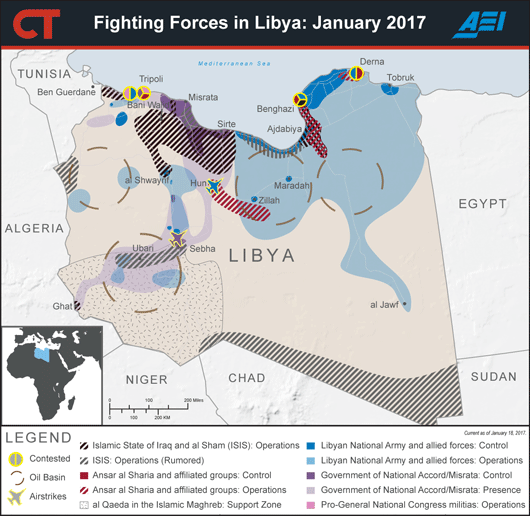{{currentView.title}}
January 18, 2017
Fighting Forces in Libya: January 2017
U.S.-backed Libyan partners are prioritizing the protection of their interests in Libya’s ongoing civil war over the fight against Salafi-jihadi groups. Misratan militias aligned with the UN-brokered Government of National Accord (GNA) and supported by U.S. air power seized Sirte from the Islamic State of Iraq and al Sham (ISIS) in December 2016. The fall of Sirte re-activated the ground conflict between the Misratans and Libya’s other most powerful faction, the Libyan National Army (LNA), over military, political, and economic dominance in Libya’s post-revolution power vacuum. The protraction of Libya’s civil war preserves the conditions that allowed ISIS and al Qaeda to take root and expand in Libya.
Libya’s rival factions are jockeying for power in oil-rich central and southern Libya. Misratan militias used the Sirte campaign to both fight ISIS and extend their influence into central Libya. The Misratans’ eastward movement brought them into direct competition with the LNA, which similarly expanded into central Libya in September 2016. The Misratans and the LNA have since deployed forces to potential frontlines in contested regions, limiting the resources that they can apply to counter ISIS and al Qaeda-linked militants in western Libya and Benghazi. Continued escalation is likely, following an LNA airstrike on a Misratan plane in al Jufra and clashes over military sites near Sebha.
The growing LNA-Misratan conflict plays in favor of ISIS and al Qaeda as LNA and Misratan militias divert resources from the fight against them. Both groups are benefitting from the time and space created by the current conflict to reset and prepare for future attacks.
- ISIS is reconstituting its combat capabilities in safe havens in western Libya. Misratan forces’ attempts to counter both ISIS and the LNA reduce pressure on ISIS, which also operates in the seams between regional rivals. ISIS will likely begin a new attack campaign to disrupt security in western Libya in early 2017. ISIS may also attempt to set conditions to regain territorial control in Libya, bolstered by active civil conflict similar to that which facilitated ISIS’s initial rise in Libya.
- ISIS and possibly al Qaeda militants broke out of besieged neighborhoods in Benghazi while the LNA directed its focus to central Libya. The dispersion of militants may compel the LNA to fight on multiple fronts and increases the likelihood of attacks on military and commercial infrastructure throughout Libya.
- The LNA-Misratan conflict strengthens and emboldens the more hardline elements within the Misratan forces. It induces moderate Misratan militias to ally with Salafi-jihadi groups, including al Qaeda-linked groups, against the LNA. This polarization allows al Qaeda-linked groups to operate within an Islamist revolutionary movement with significant popular legitimacy, advancing the development of a strong Salafi-jihadi base in Libya. Al Qaeda-linked militant groups released messages that may signal preparations for near-term attacks.
ISIS and al Qaeda should be able to recover from recent losses in the current environment. They are also able to initiate new operations that will strengthen both groups in the long term. ISIS and al Qaeda use Libya as a key regional hub and a base on the Mediterranean. These groups will use the freedom of movement provided by Libya’s civil war to pursue core objectives that include breaking North African states, expanding safe havens and governance, and attacking Europe. The resurgence of ISIS in Libya would undermine U.S. counterterrorism policy, which relies on containing ISIS’s regional affiliates while defeating the group in its core terrain.

